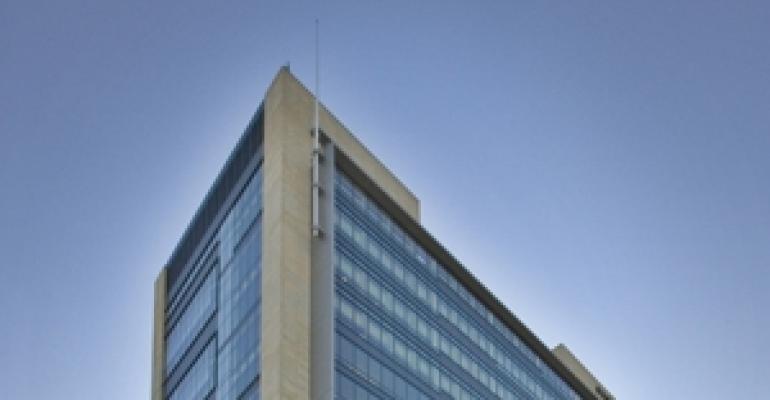Managing a large commercial complex is always a difficult task. But managing a mixed-use property that includes healthcare facilities, research labs, classrooms for higher education and retail space, all while maintaining LEED certification, requires an even greater set of skills.
That’s what real estate services firm CB Richard Ellis has been doing for the Oregon Health & Science University’s Center for Health & Healing in Portland, Ore. CBRE came on-board as project manager for the 400,000-sq.-ft. complex in early 2006, before the center was completed, and has been providing property management services ever since.
“They were looking for a service provider that could share best practices from the same industry [academic medical centers],” says Dyann Hamilton, CBRE’s alliance director for the account. “It was very important to them for us to come on-board and [bring experience] from other healthcare accounts. And the other thing was our ability to create significant value through our sourcing network, to realize savings through our contacts.”

Last year, CBRE and its wholly-owned subsidiary Trammell Crow Company completed $433 million in healthcare assignments, providing services ranging from ground-up development to construction management to project management. Among these assignments were such academic medical centers as the Cleveland Clinic in Ohio and West Penn Allegheny Health System in Pennsylvania.
In addition to experience on the corporate level, the eight-person CBRE team handling the Center for Health & Healing project brought personal healthcare experience to the job. The team’s director of engineering, for instance, had more than 20 years of experience working with an acute care hospital.
One of the most challenging aspects of the assignment so far has had to do with providing janitorial services for the property, according to Hamilton. OHSU is adamant about maintaining a class-A ambiance at the center. But because the center contains an outpatient clinic, a surgery center and laboratories, it calls for stringent cleaning procedures, including very specific requirements for disposing of bio-hazardous waste, notes Hamilton. The cleaning staff has to not only work with powerful disinfectants, but know how to avoid cross-contaminating surfaces while doing their jobs.
“It’s cleaning a space from the farthest point of exit to the exit so that all areas have been disinfected and ‘untouched’ at the point of exiting the room,” Hamilton says. “There’s a specific process that involves specialized training to ensure the prevention of infection. It is important for housekeeping staff to understand the risk of exposure to contaminated items and follow required policies and procedures.”

Plus, with the various uses coexisting at the property, janitorial staff may not have unobstructed access to some facilities. The pharmacy, for example, cannot be cleaned after it closes for the day. The job has to be done during its operating hours. It falls to CBRE to ensure that the cleaning standards have been met while coordinating maintenance with the various different schedules of each on-site use. The company has installed two day porters to clean the common areas and restricted areas Mondays through Saturdays from 7:00 a.m. to 6:00 p.m. A separate cleaning crew comes in from 5:00 p.m. to 1:00 a.m. to clean the remainder of the space.
Because of its size and property management expertise, CBRE has been able to secure GCA Services Group, a national cleaning contractor, to handle the job. It has also established key performance indicators that are monitored on a daily basis to make sure the cleaning requirements are met.
In addition, since the center has been designed as a LEED Platinum-certified property, the firm has to maintain the requirements of the green program. In many instances, that means making it as easy as possible for the center’s tenants to help adhere to the green rules.
In fact, maintaining sustainability goals has been another major part of CBRE’s task at the center. While OHSU is fully committed to green practices, some of the center’s tenants might have reservations about adhering to all the rules, says Hamilton. Or they might not be able to follow certain guidelines for practical reasons—for example, the researchers might work at the center’s lab late into the night and might not be able to limit their energy use because they need to be able to perform their experiments, says Hamilton.
To combat such issues, CBRE has been trying to get the center’s tenants on-board with the sustainability program through outreach efforts that show them how they benefit from participating in green practices.
One way the firm has done this is by putting together an annual sustainability report that shows the return on investment from sustainable practices, as well as the social and environmental benefits of being green. CBRE has also developed an eight-year optimization program for the center, which involves looking at whether its sustainability goals have been met and how performance can be improved in the future.
“We take the report to the building occupants and show them how their behavior has impacted their bottom line,” Hamilton says.
As a result of CBRE’s efforts, in 2010, the center received the Outstanding Building of the Year Award in the medical office category from the Building Owners and Managers Association. For the past three years, it has also been the recipient of the Energy Star Award.

